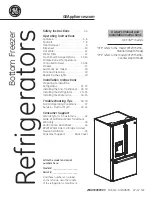
8 Cod. 80000080c – 17.07.2018
The cabinets are equipped with an
automatic system for the cyclic defrost of the evaporator
. This
system is handled by the electronic controller of the control panel. Defrost parameters are pre-set in
factory according the necessities and specificities of each unit. In particular cases it may be necessary to
manually initiate a defrost cycle, by operating the related function of the electronic controller (make
reference to the section of the manual dedicated to the electronic controller). A manual defrost will have to
be activated whenever a loss or a reduction of air flow is detected at the air-discharge grill. Such condition
occurs when the evaporator is clogged by frost, thus hindering a proper circulation of the refrigerated air. A
massive or too fast formation of frost inside the evaporator may require the manual defrost to be activated
with anomalous frequency. This is an indication of improper environment conditions, not suitable for the
use of the cabinet (too high temperature and relative humidity inside the p.o.s.), or a wrong placement of
the product inside the cabinet itself (see previous chapter, “preserving the displayed products”).
During closing time or closing holidays, it is recommended to use the so called “night blinds” or “night
covers”. This measure provides a substantial reduction of the energy consumption, and a better
preservation of the products.
Cleaning
Warning: safety first!!
Before starting any cleaning operation, it is MANDATORY to switch-off the
cabinet and to disconnect it from the main power supply by operating the sectionalising switch upstream
of the corresponding power line.
(open position in “0”, OFF or green condition). It is recommended to
apply a lockout-tagout procedure (isolation, lock and tag of all energy sources). The Lock and tag of the
isolation points lets others know not to de-isolate the cabinet during the cleaning operation. In case of
plug-in cabinets, switch off the unit and disconnect the plug from the electrical outlet.
Warning: for the cleaning of the cabinet
do not use in any case
jets or streams of water, water hose
or
high-pressure machines
. In case, only for the cleaning of the internal part of the carcass, pour lukewarm
water gently inside the carcass from a container. Pay attention
not to wet the electric parts
such as fan
motors, sensors, defrost heaters, thermometers, electronic expansion valves (if present), wiring plugs etc.
The non-observance of these requirements may lead to irreversible damages, and a consequent need of
replacement of the devices mentioned above.
Warning: the evaporator inside the carcass is made up of a tight pack of aluminum fins; the fins
represent, because of their nature, an actual
risk of injuries
(cuts and abrasions) to hands and arms. On
counters equipped with electric defrost, electric heaters could still be hot even after the cabinets is turned
off (e.g. just after a defrost cycle) with a potential risk of burns. For the above reasons the use of protecting
gloves is hardly recommended.
Warning: hot cabinets for the displaying and merchandising of pre-cooked food are equipped with
infrared lamps, typically installed inside the top canopy. The supporting structure and the lamps itself may
cause serious burns. Before any cleaning operation, let the lamps and any other hot surface cool down
properly.
For the cleaning only use lukewarm water possibly with neutral detergents and, for drying, a clean soft
cloth.
Do not use
abrasive pads
,
abrasive or corrosive detergents, thinners, alcohol or solvents of any kind.
Cleaning of the internal parts: frequency of the cleaning depends on the nature of the displayed
product. Cabinets used for the displaying of fresh product such as meat, sausages and dairy products,
require the cleaning on daily basis of all display surfaces (display decks, shelves, air grills etc.), in order to
prevent the growth and developments of bacteria. On weekly basis it is also necessary to clean the internal
bottom surface of the carcass, mostly in those cases in which the displaying cause the product to release
liquids, grease or debris. For low-temperature cabinets (for frozen products) cleaning operations should be
planned on monthly basis.
Summary of Contents for GIANO 70
Page 16: ...11 Cod 80000080c 17 07 2018...
Page 24: ...19 Cod 80001850 10 11 2014 X8 X8 X4 X4 X2 X2 4 5 6 7 8 9 10 11...
Page 25: ...20 Cod 80001850 10 11 2014 X8 X4 12 13 14...
Page 28: ...23 Cod 80002380a 04 08 2015 15 16 17 X2 18 X2 20 21 22 10 18 19...
Page 29: ...24 Cod 80002380a 04 08 2015 23 24 X2 26 X2 27 X2 28 24 27 25...
Page 45: ......
Page 46: ......
Page 47: ......














































